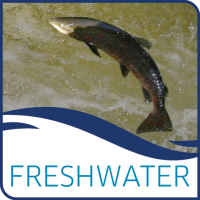Wild Atlantic salmon and brown trout are important to the rural economy, biodiversity and cultural heritage of Scotland, and valuable indicators of ecosystem health. However, their populations are in decline across much of their native range. Reliable methods are thus required to understand the status (health) of populations, identify issues requiring management (pressures), inform regulation and policy development, and meet legislative reporting requirements.
Electrofishing data are one of the most commonly collected sources of information on freshwater fish populations. However, these data are often obtained using ad-hoc sampling approaches that makes their interpretation challenging. The National Electrofishing Programme for Scotland (NEPS) was established in 2018 to assess status and trends in salmon populations and the effects of selected pressures. It consists of a statistical survey design, a set of carefully documented data collection procedures, data storage, and statistical modelling approaches to harmonise data and determine expected fish densities for healthy populations in particular habitats (the benchmark). Surveys were undertaken in 2018, 2019, 2021 and 2023 using a range of funding sources. The project is a collaboration between the Scottish Government Marine Directorate, Fisheries Management Scotland, and local fisheries managers.
This report presents results from NEPS 2023, which in addition to salmon includes assessment of trout populations for the first time. Comparisons are made to previous surveys through careful harmonisation of data to account for changing survey designs. At the national scale, the mean densities of salmon fry (fish in their first year after hatching) and parr (fish over 1 year old) were only 74% and 56% of the benchmark. Although there was substantial regional variability in performance, healthy salmon populations (both fry and parr) were only found from the Moray Firth northwards. National trout fry and parr densities in 2023 were 86% and 64% of expected densities respectively, again with substantial regional variability. There was a strong relationship between mean regional fish densities and occupancy (the proportion of the river length where fish are observed) that makes it challenging to obtain accurate assessments of status at low population levels. NEPS provides a strong basis for the assessment of freshwater fish populations and the pressures affecting them, and is able to meet a broad range of data and reporting requirements at a range of spatial scales depending on reporting requirements and availability of sampling resource.
Data and Resources
| Field | Value |
|---|---|
| Publisher | |
| Modified | 2025-06-11 |
| Release Date | 2025-06-09 |
| Identifier | 8b42b0a7-0638-4444-ac89-484856dcf362 |
| License | UK Open Government Licence (OGL) |
| Public Access Level | Public |


